To perfect your hopper batter, start with fresh, slightly soaked short-grain rice and full-fat coconut milk for rich fermentation. Rinse well and keep the batter at a steady 75-85°F in a warm, draft-free spot, covering it with breathable cloth. Use natural starters like fermented rice or ripe fruit, and guarantee the batter is smooth yet not too runny. Monitor bubbles and aroma, adjusting environment if needed. Keep exploring to master this essential step.
Key Takeaways
- Use fresh, full-fat coconut milk and natural fermentation starters to boost yeast activity and flavor development.
- Maintain batter temperature between 75°F and 85°F in a draft-free environment for optimal fermentation.
- Rinse rice thoroughly and soak for 4-6 hours to ensure proper hydration and beneficial bacteria growth.
- Keep batter at a consistent, smooth flow without being too thick or thin; adjust with water or rice flour as needed.
- Cover batter with breathable material and check for bubbles, rise, and mild tangy smell after 8-12 hours to determine readiness.
Selecting the Right Rice and Coconut Milk
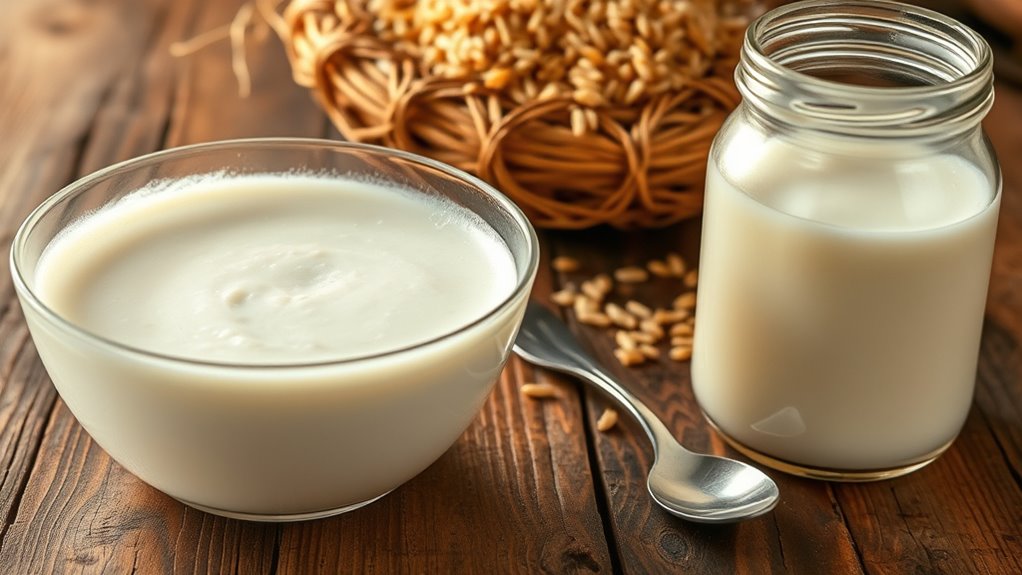
Choosing the right rice and coconut milk is essential to making authentic Sri Lankan hoppers. For the rice, opt for raw rice varieties like raw rice or even short-grain rice, as they produce a tender, slightly chewy batter. Avoid polished or overly processed rice, since they don’t ferment well. When selecting coconut milk, go for fresh, thick, and full-fat coconut milk for rich flavor and proper texture. Using canned coconut milk is fine if it’s high-quality and unsweetened. The coconut milk’s fat content helps achieve that authentic, creamy consistency in your batter. Quality ingredients make a noticeable difference in flavor and fermentation, giving your hoppers that genuine taste and perfect texture. Always choose fresh, natural ingredients to start with the best possible batter.
Proper Soaking and Rinsing Techniques
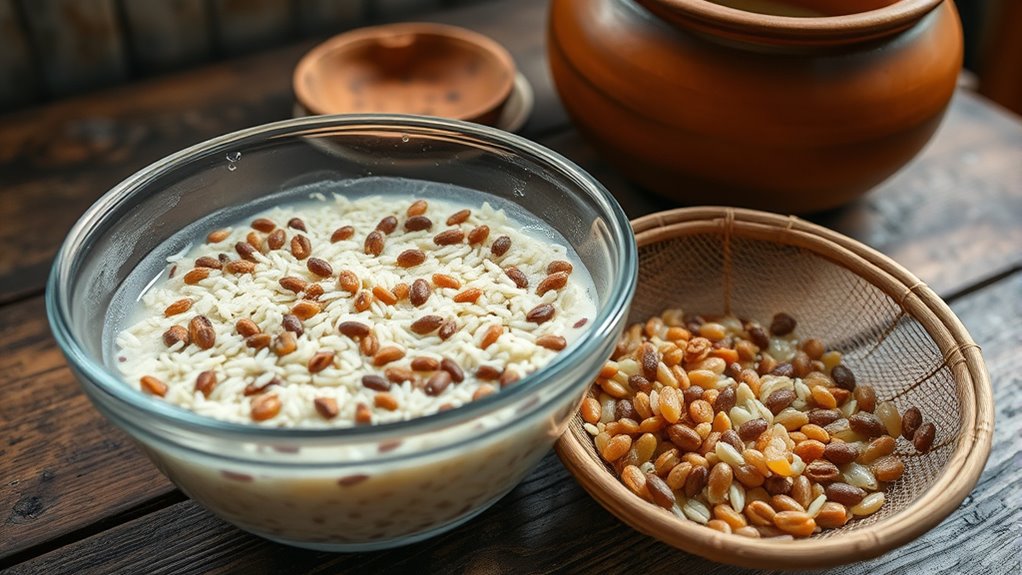
To get the best results, pay attention to soaking duration—don’t rush it. Make sure to rinse the rice thoroughly before fermentation to remove excess starch and impurities. Proper soaking and rinsing set the foundation for authentic, delicious Sri Lankan hoppers. Additionally, employing color accuracy in the process could optimize timing and consistency for perfect results.
Soaking Duration Matters
Since soaking and rinsing are crucial steps in preparing Sri Lankan hoppers, paying attention to the duration is essential for the best results. If you soak the rice flour too briefly, it won’t fully hydrate, leading to a dense batter that won’t ferment properly. On the other hand, soaking too long can cause the grains to break down, resulting in a sticky, overly soft mixture. Typically, soaking for 4 to 6 hours strikes the perfect balance, allowing the rice to absorb enough water while maintaining its structure. This ensures a smooth, pliable batter that ferments evenly and produces light, crispy hoppers. Remember, the right soaking time improves fermentation and ultimately influences the texture and flavor of your finished hoppers. Proper soaking duration is also essential for enzyme activity, which enhances fermentation and flavor development.
Rinse Thoroughly Before Fermentation
After soaking the rice flour for the ideal 4 to 6 hours, thorough rinsing becomes the next important step. Rinse the soaked flour under cold running water, gently swirling it with your fingers to remove excess starch and impurities. This step guarantees your batter develops the right fermentation qualities and prevents a sticky, overly starchy texture. Use a fine-mesh sieve or colander to drain excess water completely. Proper rinsing improves fermentation by allowing beneficial bacteria to thrive, resulting in light, airy hoppers. Skipping this step can lead to a dense, heavy batter with inconsistent fermentation. Take your time to rinse thoroughly until the water runs clear. Cleanliness here directly influences the final texture, flavor, and rise of your Sri Lankan hoppers.
Achieving the Ideal Fermentation Environment
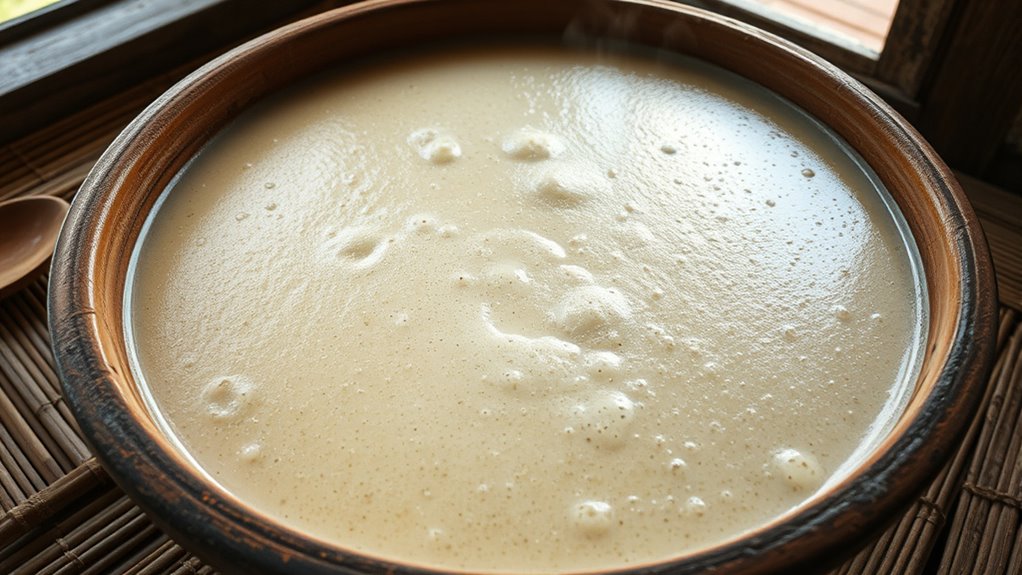
To create the perfect fermentation environment, you need to maintain the right temperature range, typically between 75°F and 85°F. Choosing the proper fermentation vessel helps regulate heat and moisture, ensuring consistent results. Pay close attention to these factors to achieve the best flavor and texture in your hoppers.
Optimal Temperature Range
What is the ideal temperature range for fermenting Sri Lankan hoppers? The perfect range is between 75°F and 85°F (24°C to 29°C). Maintaining this temperature ensures maximum yeast activity and batter fermentation. To achieve this, consider these tips:
- Keep your batter in a warm spot away from drafts or direct sunlight.
- Use a proofing box or wrap the container with a towel to insulate heat.
- If needed, place a heating pad on a low setting underneath the container to gently raise the temperature.
Staying within this range prevents under- or over-fermentation, resulting in hoppers with the right texture and flavor. Consistent temperature control is key to perfect batter fermentation every time.
Proper Fermentation Vessel
Choosing the right fermentation vessel is essential for creating a stable environment that promotes proper batter fermentation. You want a container that maintains consistent temperature and allows airflow without exposing the batter to contaminants. Glass or ceramic bowls work well because they’re non-reactive and easy to clean. If you prefer a traditional touch, a food-grade clay pot is a good option, as it helps regulate moisture and temperature naturally. Avoid metal containers, which can react with the batter and alter the flavor. Cover your vessel with a breathable cloth or paper towel to protect against dust and insects while allowing gases to escape. Keep the vessel in a warm, draft-free spot. Ensuring the fermentation environment is properly maintained can significantly improve batter quality. Proper temperature control and airflow are crucial for consistent fermentation, which leads to better hopper batter. Using the right fermentation vessel can also help minimize contamination risks and create a more controlled environment. With the right vessel, your batter will ferment evenly, resulting in perfect hopper batter. Additionally, choosing an environment with stable ambient temperature can prevent fluctuations that disrupt fermentation, ensuring optimal batter fermentation conditions.
Timing Your Fermentation for Optimal Results

Timing your fermentation is essential to achieving the perfect Sri Lankan hopper. If you wait too long, the batter may become sour and lose its lightness. If you start too early, it might not develop enough flavor or rise properly. To get it just right:
- Check your batter after 8-12 hours at room temperature.
- Look for bubbles forming and a slight rise, indicating active fermentation.
- Taste a small amount; it should be mildly tangy but not sour.
- Proper fermentation involves understanding the fermentation process, which is influenced by ambient temperature and the natural activity of the yeast and bacteria involved. The timing of fermentation can vary depending on environmental factors, so monitoring closely is key.
- Regularly filtering capabilities of your environment can help maintain consistent fermentation conditions.
Using Natural Fermentation Starters
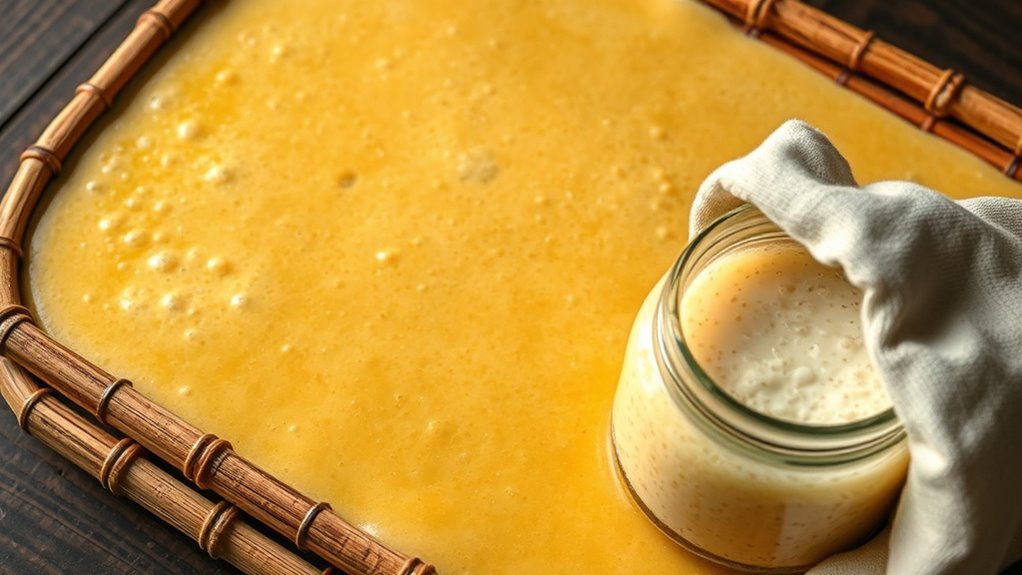
Once your batter has fermented to the right level, you can enhance its flavor and consistency by using natural fermentation starters. These starters introduce beneficial wild yeasts and bacteria from your environment, boosting fermentation naturally. To use one, simply save a small portion of your previous batter or obtain a bit from a trusted source, like a ripe fruit or fermented rice. Mix this starter into your current batter thoroughly. This process not only speeds up fermentation but also adds complexity to the flavor, giving your hoppers a richer, tangier taste. Keep in mind, natural starters vary depending on your location and ingredients, so experiment to find the right balance. Using a natural starter is a traditional way to maintain a lively, active fermentation culture.
Adjusting Batter Consistency Before Fermentation
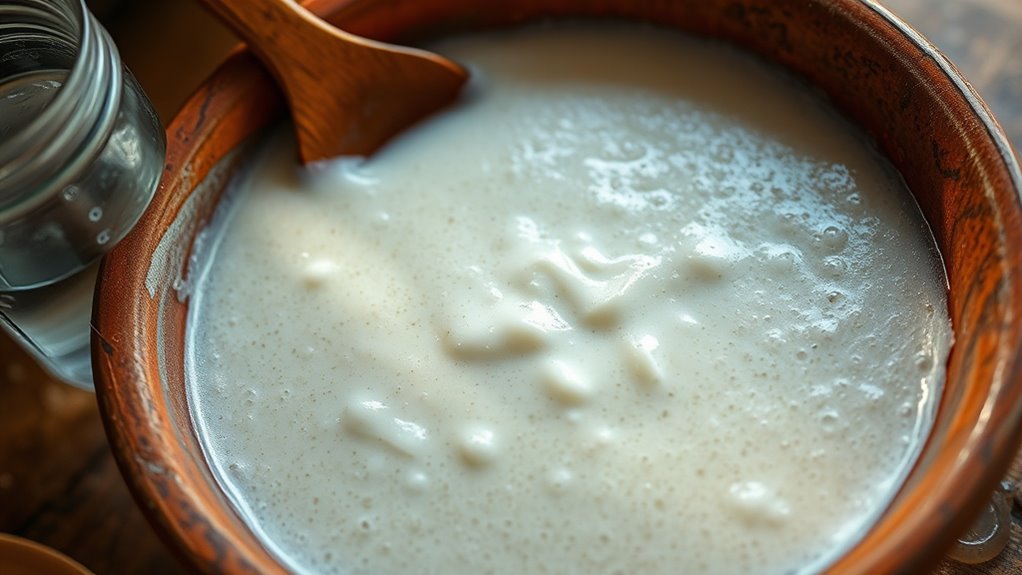
Before you let your batter ferment, it’s important to adjust its consistency to guarantee ideal results. A batter that’s too thick may result in dense hoppers, while one that’s too thin can cause them to be fragile and difficult to cook properly. To get it just right, follow these steps:
Ensure perfect hoppers by adjusting batter consistency—neither too thick nor too thin for crispy, light results.
- Check the batter’s thickness by lifting a spoon; it should flow smoothly but not be runny.
- If too thick, add small amounts of water gradually, mixing until you reach the desired consistency.
- If too thin, incorporate a little rice flour to thicken it without affecting the flavor.
- Using a well-prepared, well-drained soil ensures your batter’s consistency remains optimal during fermentation.
Achieving the right consistency ensures your hoppers will turn out light, crispy, and perfectly fermented.
Troubleshooting Common Fermentation Issues
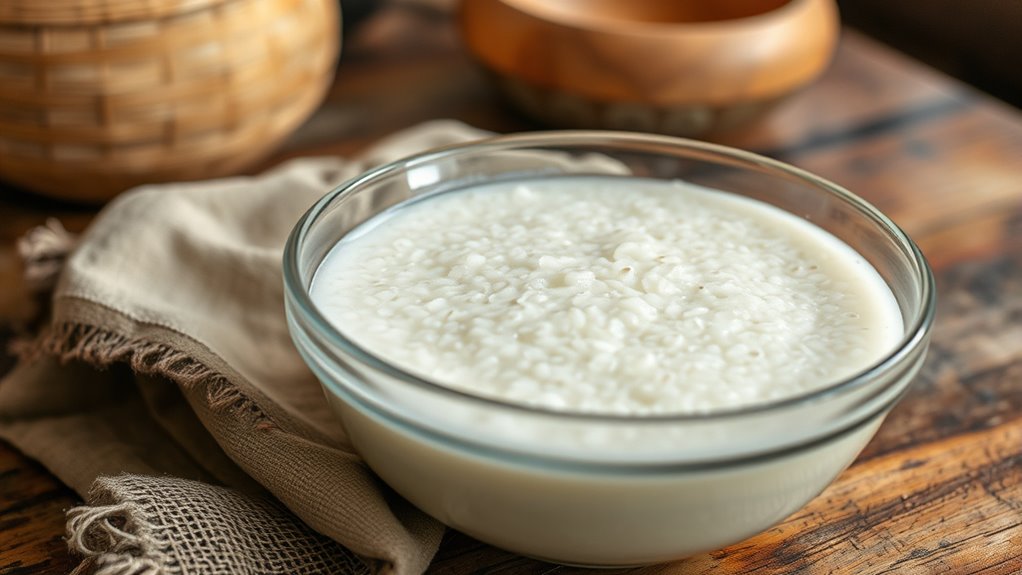
Fermentation issues with your batter can often be traced to factors like temperature, ingredient quality, or improper mixing. If your batter isn’t rising or has a sour smell, check the room temperature; fermentation slows down in cold conditions and speeds up in warmth. Make certain your ingredients, especially yeast or fermented rice, are fresh and properly prepared. Poor mixing can also hinder fermentation; make sure you’ve thoroughly combined the batter to evenly distribute the yeast or starter culture. If bubbles are absent or the batter remains flat after time, try gently stirring and placing it in a warmer spot. Sometimes, adjusting the fermentation time—either prolonging or shortening it—solves the issue. Keep experimenting with these factors to find the most suitable conditions for perfect hopper batter. Additionally, monitoring the signs of spoilage in your lemon juice can help ensure your ingredients remain fresh and safe to use during fermentation. Proper temperature control is essential for reliable fermentation results and can help prevent issues related to temperature fluctuations. Being aware of the quality of ingredients used can also significantly impact the fermentation process and final product. Ensuring your environment is free from cybersecurity vulnerabilities can prevent disruptions that might interfere with your fermentation setup if digital tools are involved.
Frequently Asked Questions
Can Different Rice Varieties Affect Fermentation Speed?
You might wonder if different rice varieties affect fermentation speed. Yes, they do. Some rice types, like sticky or aromatic rice, have unique starch compositions that influence how quickly the batter ferments. Using the right rice can lead to a smoother, faster fermentation process. Experimenting with various rice kinds helps you find the best for your desired hopper texture and fermentation time, enhancing your overall cooking results.
How Does Ambient Temperature Influence Hopper Fermentation?
Think of fermentation as a delicate dance, where ambient temperature sets the rhythm. When it’s warm, the batter wakes up and ferments faster, like a sprinter taking off from the blocks. Cooler temperatures slow down the process, making it feel like wading through molasses. Keep your environment consistent, because fluctuations can throw off the timing, resulting in either under-fermented or overly sour hopper batter.
Are There Preservatives That Hinder Natural Fermentation?
You might wonder if preservatives can hinder natural fermentation. Yes, certain preservatives, like sodium benzoate or sulfites, can slow down or stop the fermentation process by killing or inhibiting beneficial microbes. If you’re aiming for authentic fermentation, avoid using these chemicals. Instead, focus on maintaining a clean environment and proper temperature, which naturally supports the growth of the yeast and bacteria needed for successful fermentation.
How Long Can Fermented Batter Be Stored Safely?
This question is as important as discovering hidden treasure! You can store fermented batter in the fridge for up to 24-48 hours safely. After that, it’s like releasing a wild beast — it might spoil or develop off-flavors. Always smell and observe it before use. If it looks or smells off, better to discard it. Proper refrigeration keeps fermentation in check and guarantees your batter stays fresh and safe.
Can Adding Sugar Improve Fermentation Outcomes?
Adding sugar can boost fermentation by providing extra food for the yeast and bacteria, which speeds up the process and enhances flavor. You might notice a more bubbly and sour batter with a sweeter touch. However, don’t overdo it, as too much sugar can inhibit fermentation or make the batter overly sweet. Use a small amount, like a teaspoon per cup of batter, to improve your results effectively.
Conclusion
Mastering the art of fermentation turns your Sri Lankan hoppers into a culinary masterpiece that could make even the most seasoned chefs envious. With the right rice, coconut milk, and a little patience, you’ll craft batter so perfect it could warm the heart of the island itself. Don’t rush the process—trust the natural magic at play. Soon, your hoppers will rise like a phoenix, ready to delight with every crispy, fluffy bite.









